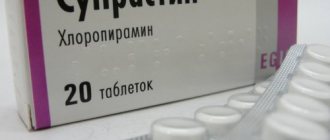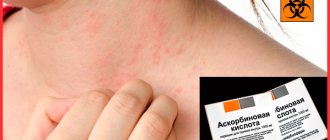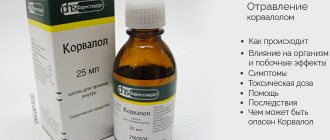Diphenhydramine has antihistamine activity and has a strong anesthetic property and exhibits an antispasmodic effect.
It is used to treat diseases such as pruritic dermatoses, hay fever, conjunctivitis caused by allergies, urticaria, and radiation sickness. Diphenhydramine is also prescribed for bronchial asthma, stomach ulcers, and to reduce side effects from blood transfusions. This drug helps with various other diseases. The medicine contains diphenhydramine or diphenhydramine. Since diphenhydramine has a central anticholinergic effect, it can cause changes in a person’s consciousness, expressed in the appearance of hallucinations, illusions, delusions, and loss of orientation in time. This is often used by drug addicts, using this medicine as an independent substance, as well as in combination with other drugs and medications. Diphenhydramine is highly soluble in alcohol. This solution can be administered intravenously for rapid absorption into the blood and producing euphoria. Even a small dose of medication (2-3 tablets) can cause severe intoxication in combination with alcohol, including beer. Motivation for addicts
Don't know how to persuade your loved one to start treatment? We will help!
The center's motivational specialists are guaranteed to convince the addict to start treatment.
8
8
8
Call the hotline and get a free consultation with a narcologist.
We work around the clock 24/7
What is the drug used for?
Diphenhydramine is a drug from the group of antihistamines, which is available in the form of tablets, as well as in the form of an injection solution in ampoules. Despite the emergence of modern analogues, the drug is still used in the following cases:
- as part of complex therapy to eliminate an allergic reaction (to food, after insect bites, etc.);
- to relieve anxiety and normalize sleep during stressful periods;
- to reduce nausea during seasickness or radiation therapy;
- to reduce the risk of adverse reactions during transfusion of blood and its components;
- to enhance the effect of anesthetics (as part of lytic mixtures);
- when stopping an attack of bronchial asthma;
- with parkinsonism.
The low cost makes Diphenhydramine accessible to patients, leaving it on the list of popular medications.
What is the outcome from the combination of alcohol and diphenhydramine?
In addition to the occurrence of hallucinations against the background of drinking an alcoholic drink with diphenhydramine, this symbiosis sometimes carries a mortal danger.
The instructions for use of diphenhydramine indicate: one dose - 1 tablet (50 mg), the maximum dose at a time is 100 mg, and per day - 250 mg.
Diphenhydramine with alcohol is even more harmful than an overdose of the drug. But the whole point is that it is impossible to name the exact amount of the drug that will cause death; this norm is different for everyone. Some people add a couple of tablets to a glass, feeling only strong intoxication and fun, and for a weaker body this amount will be enough to fall into a severe coma or die.
The effect of the drug on the body
The main active ingredient in Diphenhydramine is diphenhydramine. The component belongs to histamine receptor blockers; it relieves smooth muscle tension.
The effect of Diphenhydramine on the body allows it to be used as:
- antiallergic drug;
- antispasmodic;
- sedative;
- sleeping pills
After taking Diphenhydramine, a person feels a decrease in anxiety; Night sleep is normalized, irritability goes away.
The specific action allows us to call Diphenhydramine a soft drug. With the simultaneous administration of 2-3 injection doses, a person experiences relaxation and enters a state of mild euphoria. Visual and auditory hallucinations occur. To enhance the effect, drug addicts take the drug with alcohol and add various stimulants.
If the dosage is constantly exceeded for 14–20 days, a person may develop a persistent dependence on the medicine. We should not forget that Diphenhydramine is a drug, so an overdose can lead to dangerous consequences.
Diphenhydramine as a drug: instant addiction
When used correctly, Diphenhydramine does not cause addiction or addiction. In small dosages, the drug is absolutely safe and is still widely used in the medical field. However, when the medication is combined with alcohol or an alcohol-containing drink, Diphenhydramine causes severe hallucinations. This feature of the drug attracted the attention of young people. Diphenhydramine tablets dissolve in vodka. The effect of using such a mixture depends on the number of tablets.
2-3 tablets dissolved in a large amount of alcohol are enough for a person to feel mild euphoria. In this case, Diphenhydramine will only enhance the effect of alcohol, making the person more complacent, sociable, and active. Such drug intoxication can easily be confused with alcohol intoxication, since human behavior does not have clearly defined characteristics.
By increasing the dose to 5-10 tablets, a person gets a completely different effect. Severe, kaleidoscopic hallucinations can cause anxiety and panic attacks. The surrounding objects bifurcate, lose their shape, and a person ceases to orient himself in space and time. Clouding of consciousness is accompanied by a lack of critical thinking - that is, a person is no longer able to distinguish illusion from reality. During the action of Diphenhydramine, a person periodically “comes to his senses”. Moments of lucidity last several minutes, but memories of hallucinations remain.
As with the use of other hallucinogens, the nature of the visions caused by Diphenhydramine depends entirely on the mood and environment. Being in a calm, balanced state, a person will experience more peaceful hallucinations, while resentment, anger, and conflict can cause nightmare visions.
Euphoria from using Diphenhydramine is extremely weak or not expressed at all. The feeling of boundless happiness quickly gives way to a panic attack and unreasonable fears.
A large dose of Diphenhydramine diluted with alcohol often causes a state of narcotic sleep. In this case, the person experiences vivid dreams and is completely disconnected from the outside world. It is almost impossible to wake up a person “on Diphenhydramine”. Restless sleep can last from 2 to 12 hours. After waking up, a person experiences hallucinations for a long time.
As the dose increases, the effect becomes even more pronounced and dangerous. Throughout the day the person remains in a state of delirium. Clouded consciousness with vivid and realistic hallucinations is gradually replaced by loss of strength, depression, and apathy. Taking a large dose of Diphenhydramine (more than 10 tablets) a person risks falling into a coma.
Contraindications and side effects
The harm of Diphenhydramine manifests itself when contraindications to its use are ignored. An absolute contraindication is intolerance to the drug.
Diphenhydramine is used with caution, only as prescribed by a doctor, for certain diseases. These include:
- increased intraocular pressure (glaucoma);
- narrowing of the urinary canal due to prostatitis or adenoma;
- hypertonic disease;
- hyperthyroidism.
The medicine is not used to treat young patients, pregnant women and mothers breastfeeding. If you try to ignore the recommendations and prohibitions of specialists, you may encounter side effects of Diphenhydramine on the body:
- heart rhythm disturbance;
- sudden jumps in blood pressure;
- hand tremors;
- indigestion, vomiting;
- allergy;
- dry mouth;
- nausea;
- dizziness.
Diphenhydramine greatly increases skin sensitivity to ultraviolet rays. After being in the sun during treatment with the drug, red spots, rashes, and unbearable itching may occur. It is not recommended to work with precision instruments or drive a car or other vehicle during treatment.
Contraindications for use
Like any drug, Diphenhydramine has a number of contraindications, in the presence of which the use of the drug is strictly prohibited:
- Intolerance to the active substance and other components of the drug.
- Prostatic hyperplasia.
- Epilepsy and convulsive readiness in other diseases.
- Pathology of the bladder in the form of cervical stenosis.
- Some types of metabolic disorders.
- Breastfeeding period.
- Angle-closure glaucoma.
- Ulcerative diseases of the stomach and intestines with symptoms of stenosis.
- Children and teenagers up to 14 years of age.
Given the large number of restrictions on the use of the drug, Diphenhydramine should be used with caution and strictly follow the recommended dosages
Symptoms of Diphenhydramine overdose
Poisoning often occurs with an uncontrolled increase in the dose of the drug. Main symptoms:
- drop in blood pressure, weakness;
- intermittent breathing, shortness of breath;
- dizziness;
- Strong headache;
- vomit;
- dry mouth;
- blurred vision;
- involuntary contraction of the muscles of the limbs.
When taking more than 2 doses, a person experiences mental disorders , which is expressed in overexcitation, increased irritability and insomnia. In case of poisoning, the patient may experience extremes: drowsiness during the day is replaced by wakefulness at night. He begins to rave, gets confused about facts, and his behavior becomes atypical. Hallucinations may occur.
Interruptions occur in the functioning of the cardiovascular and hematopoietic systems:
- drop in the number of red blood cells;
- platelet reduction;
- decreased blood pressure;
- decrease in heart rate to 35–40 beats per minute.
If the dosage is exceeded for a long time, the patient develops dysfunctions of the urinary and reproductive systems:
- swelling due to poor urine flow;
- frequent urge to go to the toilet;
- unstable erection in men;
- disruption of the menstrual cycle in women.
Diphenhydramine poisoning manifests itself differently in each person. The symptoms listed above include sweating or hyperthermia of the skin, redness of the face and chest. This condition requires urgent medical attention and threatens loss of consciousness and cardiac arrest.
An overdose of a sedative occurs in the following situations:
- erroneous administration of an increased dose, incorrect calculation of the total number of tablets taken;
- intentional use in a state of mental overexcitation;
- using Diphenhydramine simultaneously with alcohol;
- combining Diphenhydramine and other drugs based on monoamine oxidase in one therapeutic course;
- the intentional desire of a drug addict to achieve a “high.”
The lethal dose of Diphenhydramine depends on the age and health of the victim. For an ordinary person, the risk of death occurs with the simultaneous use of 100 tablets (7.5 g). People who decide to commit suicide swallow exactly this number of tablets of the drug.
With prolonged use of the product, addiction develops. Therefore, the dangerous amount of Diphenhydramine for drug addicts is higher than for healthy people.
For children, the lethal dose may be as little as 1–2 tablets. Diphenhydramine blocks brain impulses, leading to disruption of the respiratory and motor systems. Parents should remember the danger and keep the drug out of the reach of children.
Consequences of using Diphenhydramine as a drug
Regular use of a hallucinogen in combination with alcohol cannot but affect human health. The first and most dangerous consequence of such experiments on creation is severe physical dependence. After the first dose, a person feels panic attacks, becomes depressed, and suffers from anxiety without another dose.
Other, no less tragic consequences include:
- diseases of the cardiovascular system;
- myocardial infarction;
- depression of consciousness;
- psychoses;
- suicidal tendencies and suicide attempts.
The result of drug dreams can be the painful death of a person. To prevent this, it is extremely important to identify addiction in time and seek help from specialists at a rehabilitation center.
27.10.2015 24439
Share
First aid for an overdose of Diphenhydramine
If an overdose of a sedative is suspected, measures must be taken to remove the substance from the body. Without waiting for the ambulance to arrive, it is necessary to cleanse the stomach:
- give the victim a few glasses of warm saline solution or clean water;
- induce vomiting by irritating the root of the tongue;
- repeat gastric lavage until clean rinsing water is discharged.
In the first hours, you need to take any sorbent: activated carbon, Enterosgel, Fitomucil, Smecta, etc. In the absence of medicines, you can give natural fiber: crushed oatmeal, bran. To relieve intoxication, you should drink Atoxil, which absorbs the remains of Diphenhydramine and quickly removes them from the intestines naturally.
It is necessary to monitor the consciousness of the victim, apply a cold compress to the forehead, and ensure a stable supply of oxygen.
An interesting article will help you understand the algorithm of actions: Novopassit overdose. Further treatment is carried out in a hospital using stronger medications.
Diphenhydramine addiction
The combination of diphenhydramine with beer is an addictive drug. Addiction develops quite quickly and ends with treatment in a drug clinic. In order to bring a person with such addictions back to normal, it is necessary to detoxify, remove somatic manifestations, and put the person’s psyche and memory in order. Thought processes degrade intensively, and therefore they also have to be restored.
The patient who has completed the course is returned to his family, who will have to monitor the person’s future life and prevent the return of previous addictions. The only thing worth saying in this regard is that it is better not to start drinking beer with diphenhydramine, so as not to risk your health and life, and not to become a victim of addiction in the future.
Treatment of intoxication
Upon admission to the hospital, the victim undergoes gastric lavage through a tube using saline solution. To cleanse the blood, transfusions of plasma and plasma-substituting fluids are used. Hemodialysis is possible.
If the patient has taken too many Diphenhydramine tablets, an overdose will lead to a severe coma and disruption of the heart. Until vital functions are restored, the patient is placed on an artificial respiration apparatus and diuretics are administered to reduce swelling of the internal organs.
No special antidote has been developed for Diphenhydramine . In severe cases, Sibazon is used, which binds drug molecules, reducing the risk of death. It is most difficult to detoxify drug addicts, whose bodies have long adapted to the drug. In this situation, treatment may not give the desired result and may lead to impaired brain function or death of the victim.
Acute intoxication. Clinical picture
The clinical manifestations of diphenhydramine delirium are similar to cyclodol delirium[2]. The environment preceding intoxication (“set and setting”) usually determines what kind of affective (emotional) background there will be during intoxication (from fear to euphoria), as well as the essence of visual hallucinations[2]. Visual hallucinations are kaleidoscopic, characterized by a rapid change of pictures and episodes [2]. When the previous situation is unfavorable, for example, skirmishes and fights with other people, the visions are dominated by pictures of battles and carnage[2]. In this case, substance abusers see people threatening to kill them[2].
At the peak of delirium, criticality towards hallucinations disappears, the substance abuser becomes dangerous to himself and others[2].
In the case of a combination of high doses of alcohol and diphenhydramine, perception disorders and affective disorders become even more pronounced and severe [2]. Since diphenhydramine dissolves well in alcohol, 5-10 tablets facilitate the absorption of the drug and accelerate the development of delirium [3].
Often, teenagers use diphenhydramine along with alcohol to achieve a state of “stunning”, according to A. S. Tiganov, “one of the forms of euphoria” [1]: 400.
Atropine causes similar mental disorders; diphenhydramine and atropine delirium are very similar.
The consequences of abuse of antihistamines are much more serious than, for example, tranquilizers[4]. Antihistamines and diphenhydramine in particular can, with prolonged abuse, lead to psychoorganic syndrome and seriously damage the intellect and memory [4].
Consequences
After completion of treatment, the patient will undergo long-term rehabilitation. The consequences of an overdose of Diphenhydramine can manifest themselves for a long time in the form of forgetfulness, drowsiness, and decreased attention. A person suffers from headaches, frequent migraine attacks, and a feeling of lack of air.
If you are addicted to a drug, special rehabilitation is necessary. It includes treatment of addiction using various medicinal methods and supervision of a psychotherapist. If necessary, take sedatives and sleeping pills. Diphenhydramine is replaced with lighter analogues.
Causes of overdose, how it manifests itself
Combining the drug with alcohol increases depression of the central nervous system. When taking Diphenhydramine simultaneously and MAO inhibitors (1st generation antidepressants that block the action of the enzyme monoamine oxidase), anticholinergic effects such as drowsiness, confusion and others are enhanced and prolonged. An overdose usually manifests itself with the following symptoms:
- dryness of the oral mucosa;
- difficulty breathing;
- pathological dilation of the pupil;
- hyperemia;
- depression or hyperexcitability of the central nervous system;
- clouding of mind;
- in childhood – convulsions, possibly fatal.
In case of an overdose of the drug, it is necessary to artificially induce a gag reflex, lavage the gastric cavity, take sorbents, carefully monitor breathing and blood pressure levels, symptomatic and supportive treatment.
When taken together with alcohol-containing drugs or drinks, the drug significantly enhances its effect and can manifest itself as severe hallucinations. 2-3 tablets dissolved in alcohol cause mild narcotic intoxication. 5–10 tablets accompanied by alcohol cause severe hallucinations, clouding of consciousness, and a panic attack. Regular use of the drug with alcohol-containing drinks leads to the formation of severe physical dependence.
Prevention of poisoning
It is easy to avoid an overdose of Diphenhydramine if you strictly follow all treatment recommendations. The calculation of the daily dose should be carried out by the attending physician, with whom any changes in condition, the appearance of tremor or increased neurosis should be discussed. It is necessary to warn your doctor about taking hormonal medications and diuretics.
During the course of treatment, it is better to abstain from alcohol and follow a light diet. When the result is achieved, you can ask your doctor to select a lighter sleeping pill or sedative on a natural basis to prevent the development of addiction.
Diphenhydramine - method of application:
Inside. Adults, 30-50 mg 1-3 times a day. The course of treatment is 10-15 days. Higher dosages for adults: single - 100 mg, daily - 250 mg. For insomnia - 50 mg 20-30 minutes before bedtime. For the treatment of idiopathic and postencephalitic parkinsonism - initially, 25 mg 3 times a day, followed by a gradual increase in dosage, if required, up to 50 mg 4 times a day. For motion sickness - 25-50 mg every 4-6 hours if necessary. Children 2-6 years old - 12.5-25 mg, 6-12 years old - 25-50 mg every 6-8 hours (no more than 75 mg/day for children 2-6 years old and no more than 150 mg/day for children 6 years old) -12 years old). IM, 50-250 mg; the highest single dosage is 50 mg, daily dosage is 150 mg. IV drip - 20-50 mg (in 75-100 ml of 0.9% NaCl solution). Rectally. Suppositories are administered 1-2 times a day after a cleansing enema or spontaneous bowel movement. Children under 3 years old - 5 mg, 3-4 years old - 10 mg; 5-7 years - 15 mg, 8-14 years - 20 mg. In ophthalmology: instill 1-2 drops of a 0.2-0.5% solution into the conjunctival sac 2-3-5 times a day. Intranasally. For allergic vasomotor, acute rhinitis, rhinosinusopathy, it is prescribed in the form of sticks containing 0.05 g of diphenhydramine. Diphenhydramine gel is used externally. Apply a thin layer to the affected areas of the skin several times a day.











